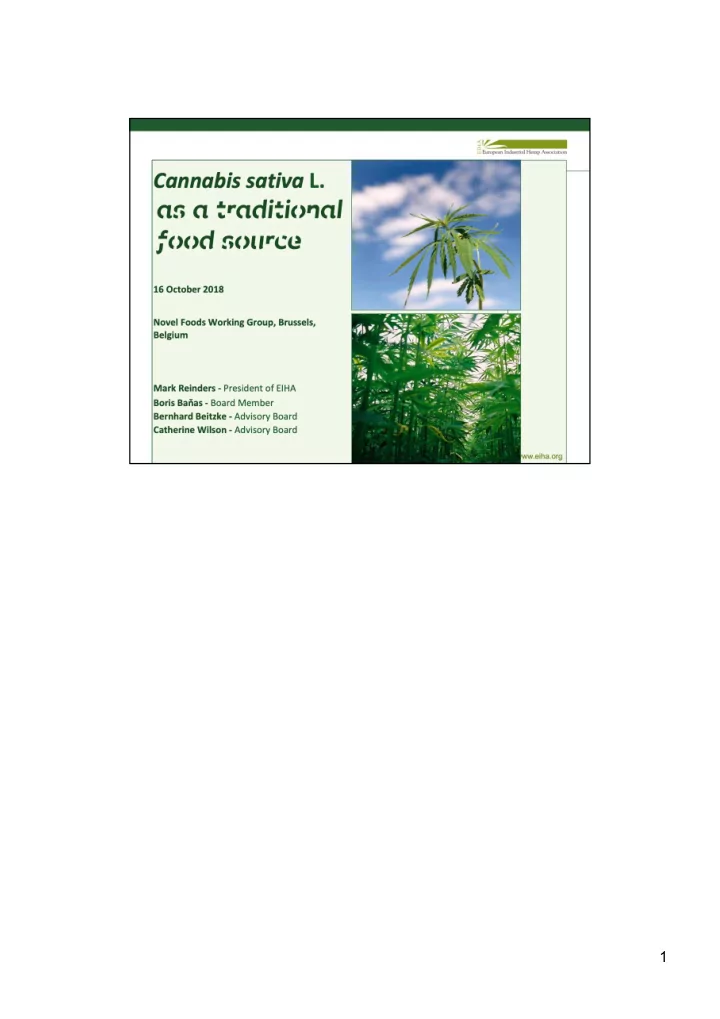

1
2
3
4
5
6
In the following three minutes, I will elaborate on the three main reasons why extracts of industrial hemp are traditional, rather than novel food. One : Hemp is a different type of genus Cannabis species from those used in medicinal or recreational applications. Two: If we understand emergence of agriculture to be connected with the development of species Homo Sapiens , then genus Cannabis has been humankind’s true companion ever since. Three: Cannabidiol has been proven safe by WHO experts on drug dependence and has been a major driver behind unprecedented expansion of hemp cultivation areas worldwide. 7
Our first argument is that while botanical taxonomies may collide, the United Nations Office on Drug and Crime sets clear rules how to distinguish between a “drug type” and a “fiber type“ cannabis plants by a formula where Cannabidiol is a denominator. In practice, countries rather mention maximum Tetrahydrocannabinol content in hemp. In general, the EU limit is 0.2% in upper third of the plant, while 0.3% applies in Canada, USA, Czechia and Austria and 1.0% THC applies in Switzerland and Australia for hemp.
Concerning our second argument: Hemp is a true biorefinery: providing renewable and carbon-neutral, sometimes even carbon-nagative intermediates. Examples are fiber for insulation, for plastic composites and fine papers, woody core for hemp concrete and animal bedding, seeds and foliage for foods and whole plant for feed silage. With a widespread use of hemp in European area since middle-ages, it would be extremely bold to argue that most parts of the hemp plant had not been used as food or in food. Hemp extracts and tinctures were indeed made and sold in products which would be called nowadays “supplements” up to 80 years ago. 9
Hemp was called a Billion Dollar Crop in 1930’s already. However, severe discrimination in the second half of the 20 th century happened when many countries applied international anti-drug conventions in the unnecessarily strict way to hemp. Hemp has almost disappeared from our daily life and from our kitchen cabinets. Luckily, countries like France and Lithuania, with highest acreage in Europe, have been a leading example of its ongoing use. Other evidence is at hand proving use of hemp green parts in applications such as beer brewing and teas which we will show later. 11
12
Last but not least, our third approach shows that CBD-containing extracts actually promote individual as well as public health and welfare. The safety profile will be discussed by Dr. Bernhard Beitzke, Catherine Wilson will demonstrate a plethora of evidence of traditional usage of ready-to-eat products with CBD concentrations considered natural within EU perspective. In conclusion, we will present our regulatory guidance proposal for hemp extracts containing Cannabidiol on the traditional food market. 13
Unprecedented demand makes hemp one of the most rapidly growing market segment this century. This can be demonstrated by increase in cultivation areas in the western world, however small compared to other agricultural commodities. Hemp foods are recognized as health promoting. General consumer patterns have shifted towards a healthier diet whilst at the same time people wanting more environmentally friendly products. This provides an excellent opportunity to reinstate hemp in good faith acknowledging its traditional use. 14
15
16
17
18
19
20
21
22
23
24
25
26
27
28
29
30
31
32
33
35
36
37
38
39
Recommend
More recommend